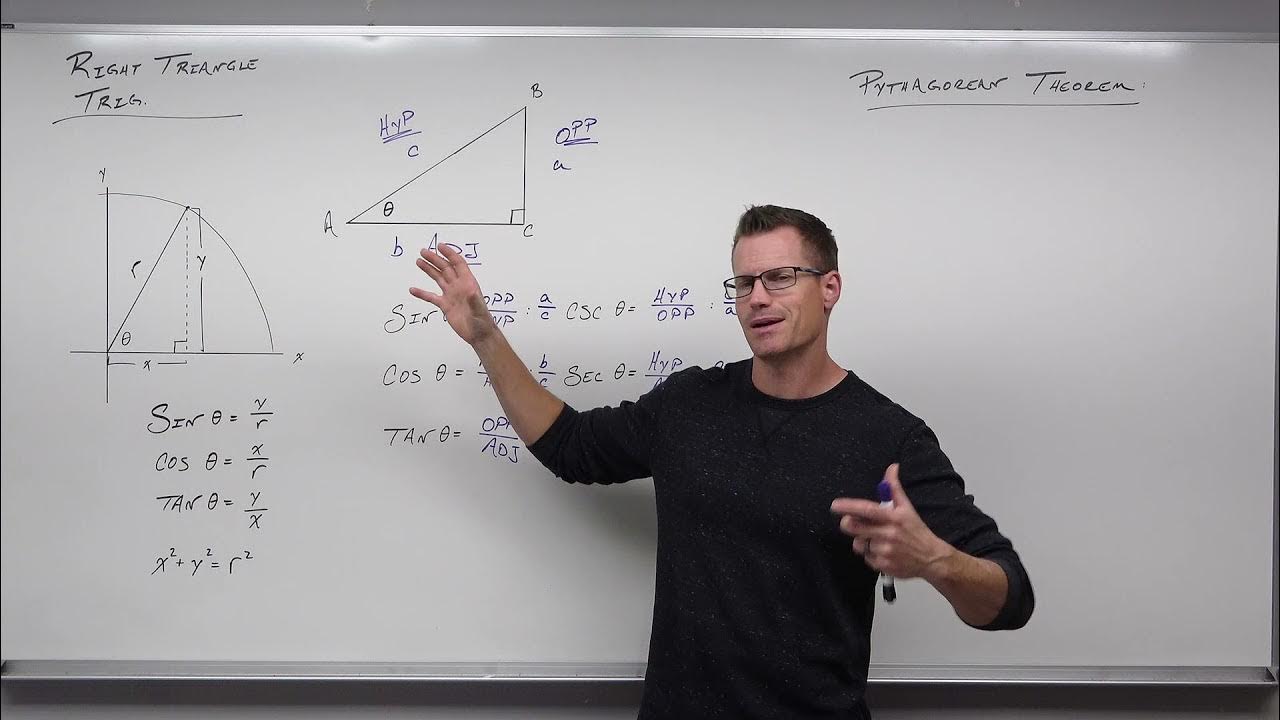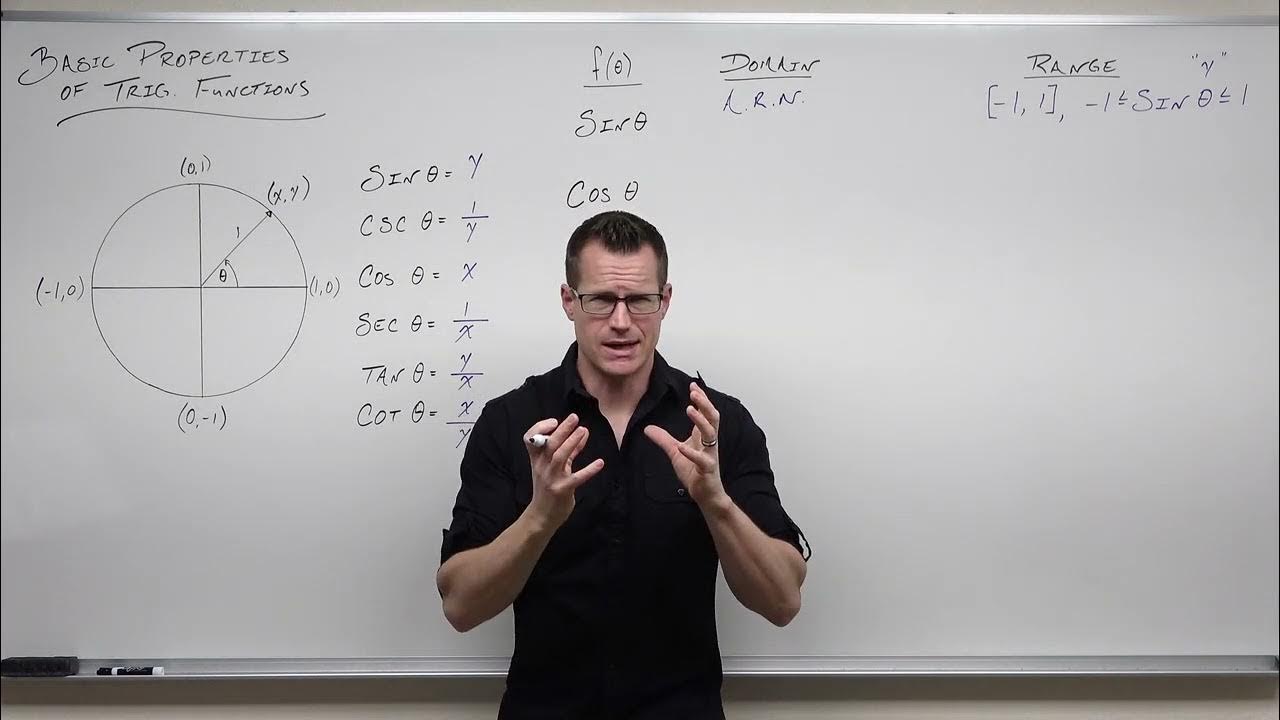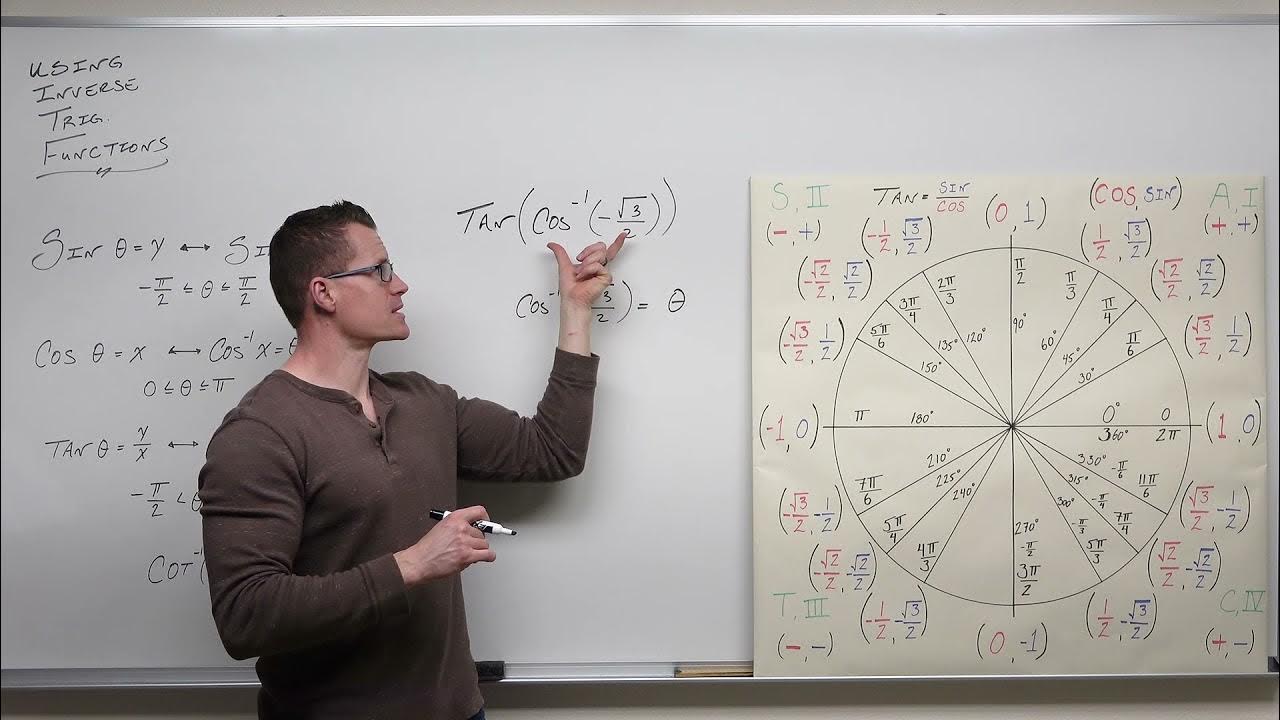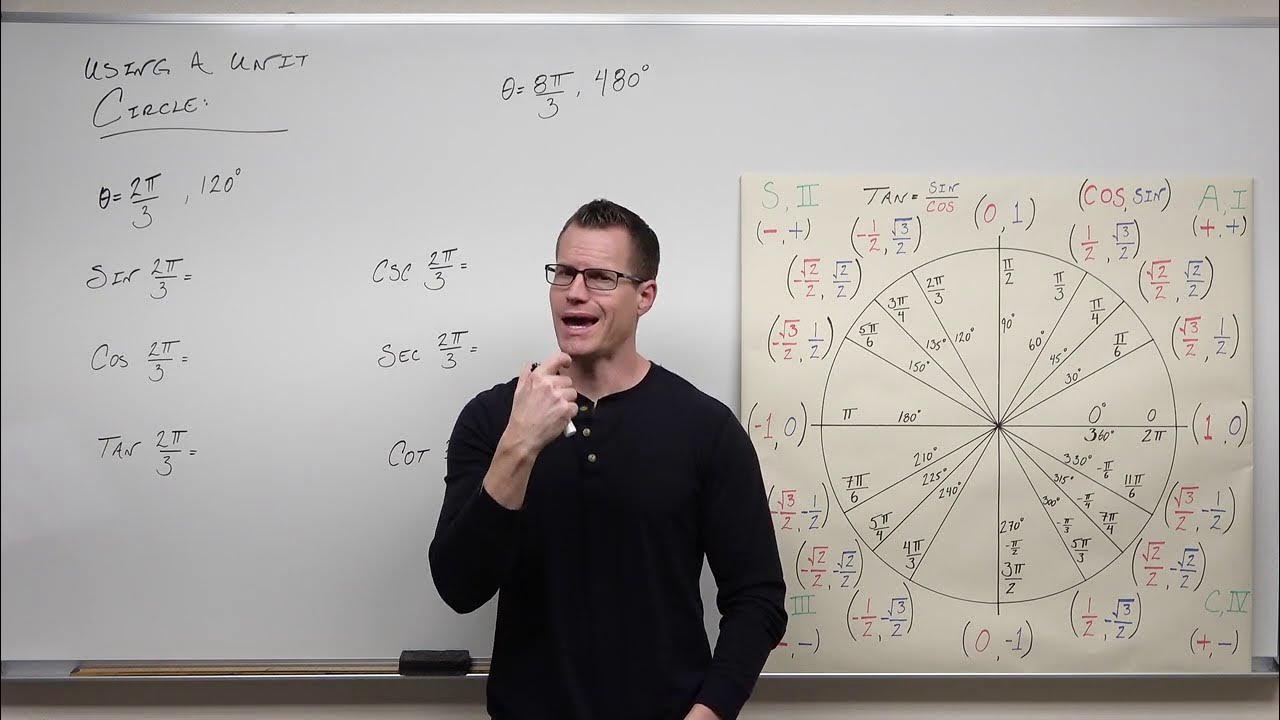Trig Visualized: One Diagram to Rule them All (six trig functions in one diagram)
TLDRThis educational script introduces the trigonometric functions using a unit circle and the concept of angle rotation. It explains how sine, cosine, tangent, secant, cotangent, and cosecant are derived from the circle and their relationships with complementary angles. The script also highlights the limits of these functions at specific angles, such as pi/2 and 0, and emphasizes the Pythagorean identities that connect the trigonometric functions. The goal is to help viewers visualize and understand these concepts for easier memorization and application.
Takeaways
- 📐 The unit circle with radius 1 is fundamental in understanding trigonometric functions, with its relation to angles and coordinates.
- 🎶 The sine of an angle (Theta) is the vertical distance from a point on the circle to the x-axis, while the cosine is the horizontal distance to the y-axis.
- 🌐 The coordinates of a point on the unit circle are given by (cosine Theta, sine Theta), reflecting the relationship between angles and their trigonometric values.
- 🔄 Complementary angles in the first quadrant have a special relationship: cosine of Theta equals sine of (pi/2 - Theta).
- 📏 The tangent of Theta is derived from the ratio of the line segment D to the radius (1), which is the sine of Theta divided by the cosine of Theta.
- 🔽 The secant of Theta is the reciprocal of the cosine of Theta, found by using the similarity of triangles to compute the hypotenuse length.
- 🔼 The cotangent of Theta is the reciprocal of the tangent, found by drawing a line perpendicular to the radius from the circle to the y-axis.
- 🚫 At pi/2, both tangent and secant are undefined as their respective lines do not intersect the x-axis.
- 📈 The sine and cosine functions are bounded by the unit circle, meaning their outputs range from -1 to 1.
- 📊 The Pythagorean theorem is applied to derive fundamental trigonometric identities: sin²Θ + cos²Θ = 1, 1 + tan²Θ = sec²Θ, and 1 + cot²Θ = csc²Θ.
- 🔄 These identities reflect the inherent symmetry and relationships in the unit circle and the trigonometric functions derived from it.
Q & A
What is the purpose of the unit circle in trigonometry?
-The unit circle, which has a radius of 1, is used as a reference for defining the trigonometric functions sine, cosine, tangent, and their reciprocals for any angle.
How are sine and cosine of an angle related to the coordinates of a point on the unit circle?
-The sine of an angle is the vertical distance and the cosine is the horizontal distance from the point on the unit circle to the respective axes, giving the point coordinates as (cosine, sine).
What is the relationship between the cosine of an angle and the sine of its complementary angle?
-The cosine of an angle is equal to the sine of its complementary angle, which is pi/2 minus the original angle.
How is the tangent of an angle defined using the unit circle?
-The tangent of an angle is the ratio of the side length opposite the angle (D) to the adjacent side length (1) in the right triangle formed by the radius and the tangent line to the unit circle.
What happens to the tangent and secant values when the angle is pi/2?
-The tangent and secant are undefined at pi/2 because their respective lines do not intersect the x-axis.
What are the ranges of the sine, cosine, cosecant, and secant functions?
-The sine and cosine functions have ranges from -1 to 1, as they cannot extend beyond the unit circle. The cosecant and secant functions have absolute values greater than or equal to 1.
How do the tangent and cotangent functions' ranges compare?
-The tangent and cotangent functions can take on any value between negative infinity and infinity as they vary with the angle around the unit circle.
What is the Pythagorean identity derived from the basic right triangle of the unit circle?
-The Pythagorean identity is that the sine squared of theta plus the cosine squared of theta equals one.
What is the relationship between the tangent and secant functions in their derived identities?
-The identity states that one plus the tangent squared of theta must equal the secant squared of theta.
What does the prefix 'co-' stand for in trigonometric functions like cosecant and cotangent?
-The prefix 'co-' stands for complementary, indicating that these functions are related to the complementary angles in trigonometry.
How can the trigonometric identities be visualized using the unit circle diagram?
-The unit circle diagram helps visualize the relationships between the trigonometric functions and their reciprocals, as well as how these relationships change with the angle, providing a visual aid for understanding the identities.
Outlines
📊 Understanding Trigonometric Functions with a Unit Circle
This paragraph introduces the concept of trigonometric functions using a unit circle. It explains how the sine and cosine of an angle (Theta) are derived from the vertical and horizontal distances from a point on the circle to the x-axis and y-axis, respectively. The complementary angle's relationship to the trigonometric functions is also highlighted. The paragraph further discusses the tangent, secant, cotangent, and cosecant of an angle, illustrating their derivations through triangle similarity. The limitations of these functions at certain angles, such as undefined values for tangent and secant at pi/2 and for cotangent and cosecant at 0, are also mentioned. The paragraph concludes by exploring the range of values for sine, cosine, secant, and cosecant, and the extreme values for tangent and cotangent. It emphasizes the Pythagorean relationships between the trigonometric functions and their complementary angles, highlighting the foundational role of triangle similarity in these concepts.
Mindmap
Keywords
💡Trigonometric Functions
💡Unit Circle
💡Angle Theta
💡Sine
💡Cosine
💡Tangent
💡Secant
💡Cotangent
💡Cosecant
💡Complementary Angle
💡Pythagorean Theorem
Highlights
The use of a unit circle with radius 1 as a foundational concept for understanding trigonometric functions.
Rotation of the radius by an angle Theta and the resulting vertical and horizontal distances from the point on the circle to the axes, defining sine and cosine of Theta.
The coordinates of a point on the circle are given by (cosine Theta, sine Theta), linking the position to trigonometric functions.
The relationship between the cosine of Theta and the sine of the complementary angle (pi/2 - Theta), highlighting the interconnectedness of trigonometric functions.
The derivation of the tangent of Theta as the ratio of the vertical line segment (D) to the radius, demonstrating the use of similar triangles.
The calculation of the secant of Theta as the reciprocal of the cosine of Theta, further exploring the relationships between trigonometric functions.
The cotangent of Theta is defined as the ratio of the horizontal line segment (D) to the sine of Theta, using similar triangles for derivation.
The cosecant of Theta is derived from the length of the line segment perpendicular to the radius that connects to the y-axis, again using triangle similarity.
The limitations of the tangent and secant functions at pi/2, where they become undefined due to the lack of intersection with the x-axis.
The undefined nature of the cotangent and cosecant functions at Theta equals zero, highlighting the boundaries of these functions.
The range of the sine and cosine functions is between -1 and 1, constrained by the radius of the unit circle.
The absolute values of the cosecant and secant functions are greater than or equal to 1, derived from the properties of the unit circle.
The tangent and cotangent functions can take any value from negative infinity to infinity as Theta varies, indicating their dynamic range.
The application of the Pythagorean theorem to the original right triangle to derive the fundamental identity sin^2(Theta) + cos^2(Theta) = 1.
The relationship between the tangent and secant functions, expressed as 1 + tan^2(Theta) = sec^2(Theta), from the derived right triangles.
The identity involving cotangent and cosecant, 1 + cot^2(Theta) = csc^2(Theta), showing the symmetry in the relationships of these functions.
The insight that all three derived identities are essentially the same, originating from the concept of triangle similarity.
The prefix 'Co' in trigonometric terms like cosecant and secant stands for 'complementary', linking these functions to their corresponding complementary angles.
The potential for discovering additional trigonometric identities within the diagram through observation of varying angles and static representations.
Transcripts
Browse More Related Video

30-60-90 Triangles - Special Right Triangle Trigonometry

Even and Odd Trigonometric Functions & Identities - Evaluating Sine, Cosine, & Tangent

Introduction to Right Triangle Trigonometry (Precalculus - Trigonometry 30)

Basic Properties of Trigonometric Functions (Precalculus - Trigonometry 8)

An Indepth Look at Using Inverse Trig Functions (Precalculus - Trigonometry 21)

How to Use the Unit Circle in Trigonometry (Precalculus - Trigonometry 7)
5.0 / 5 (0 votes)
Thanks for rating: